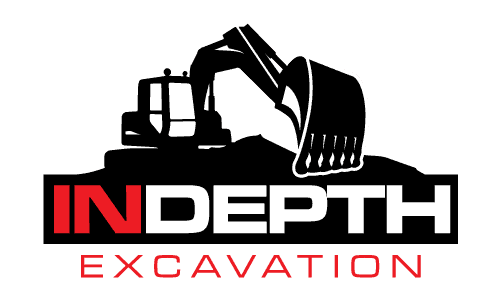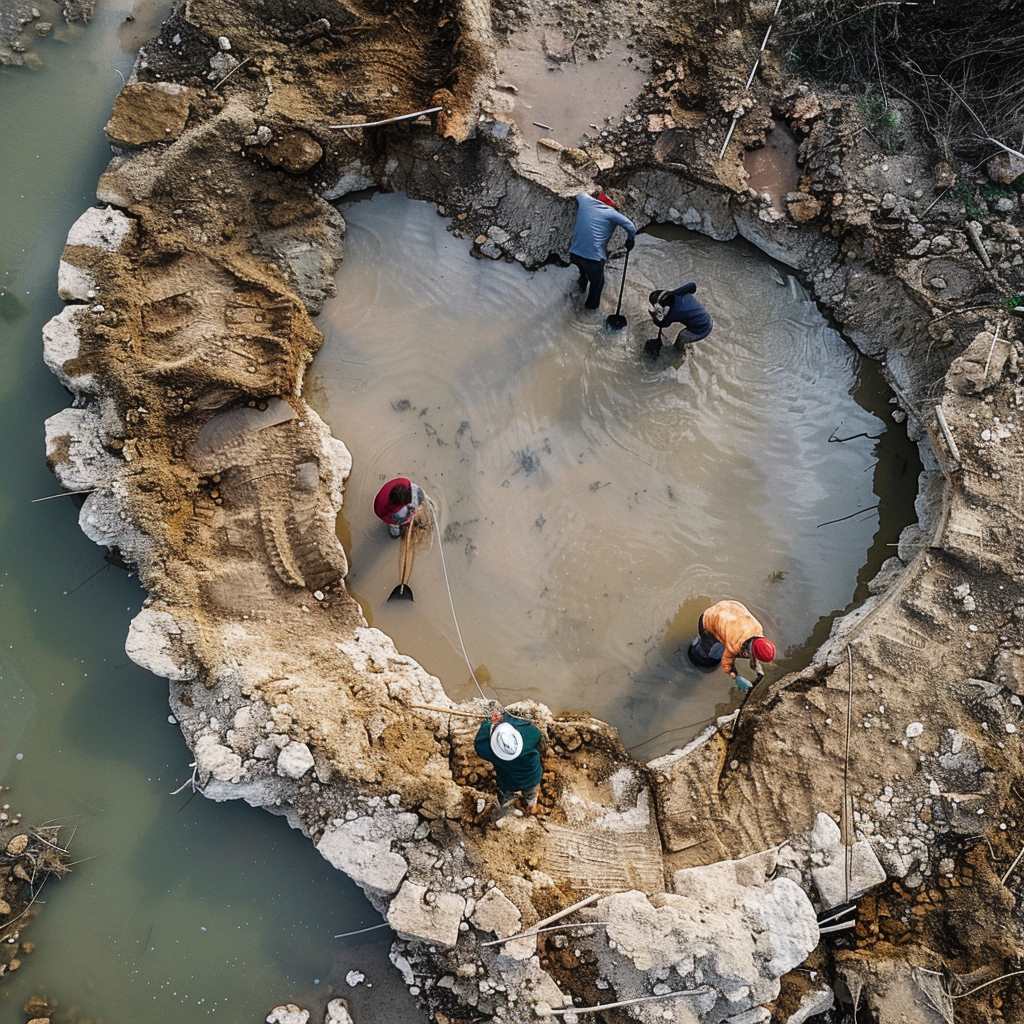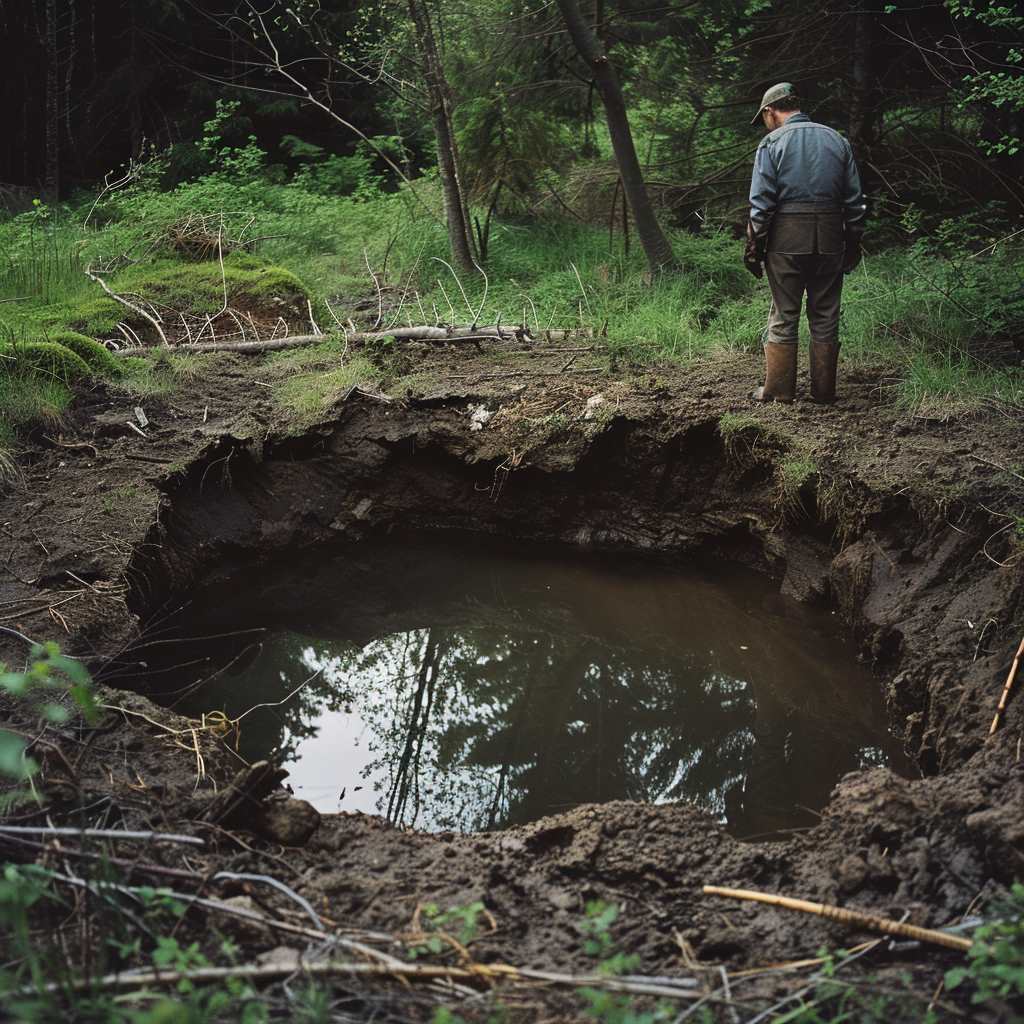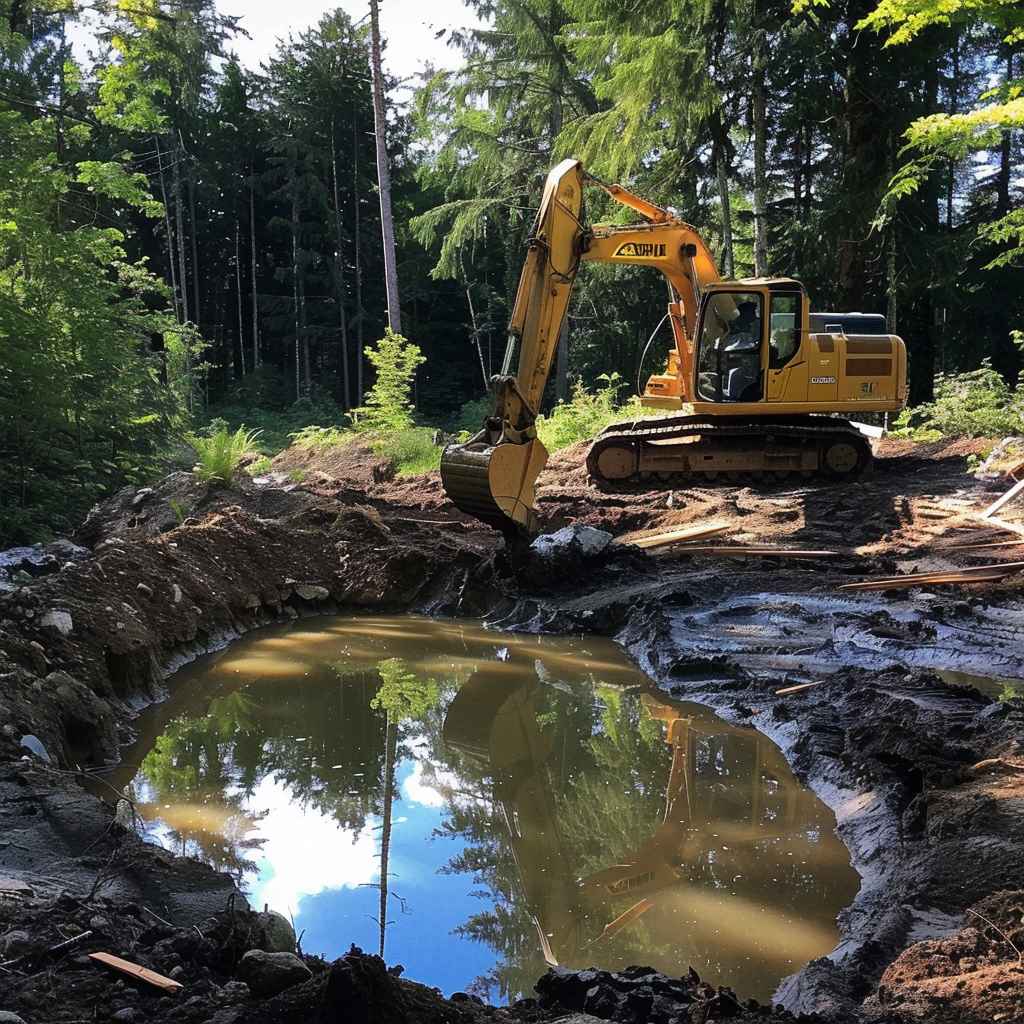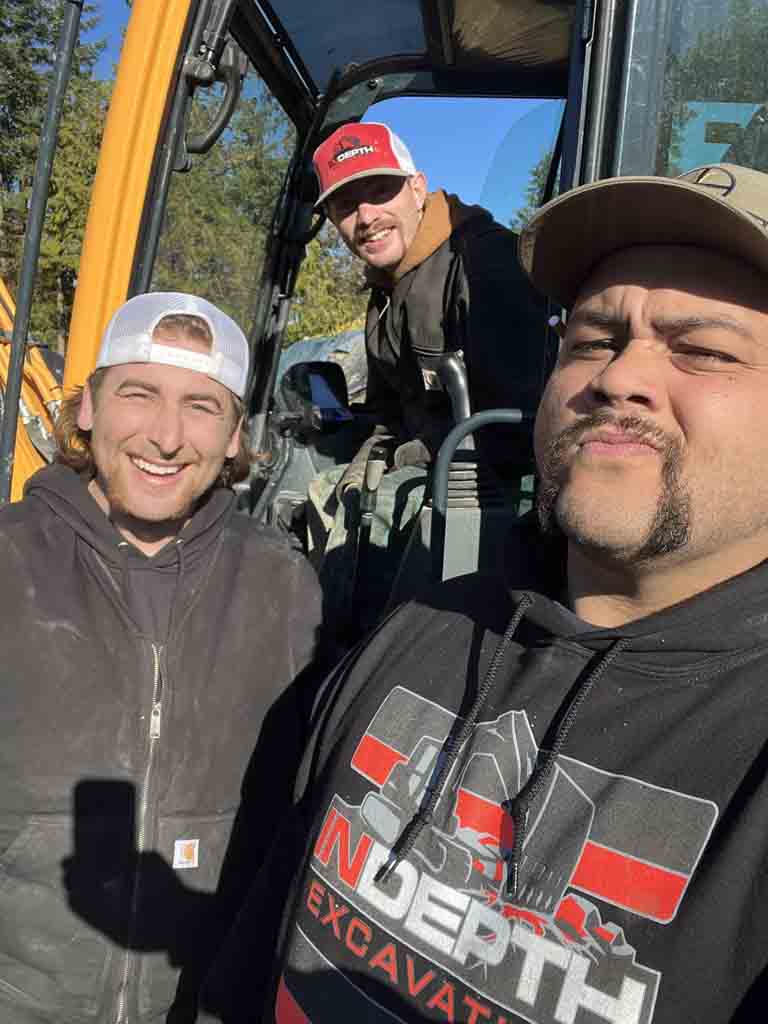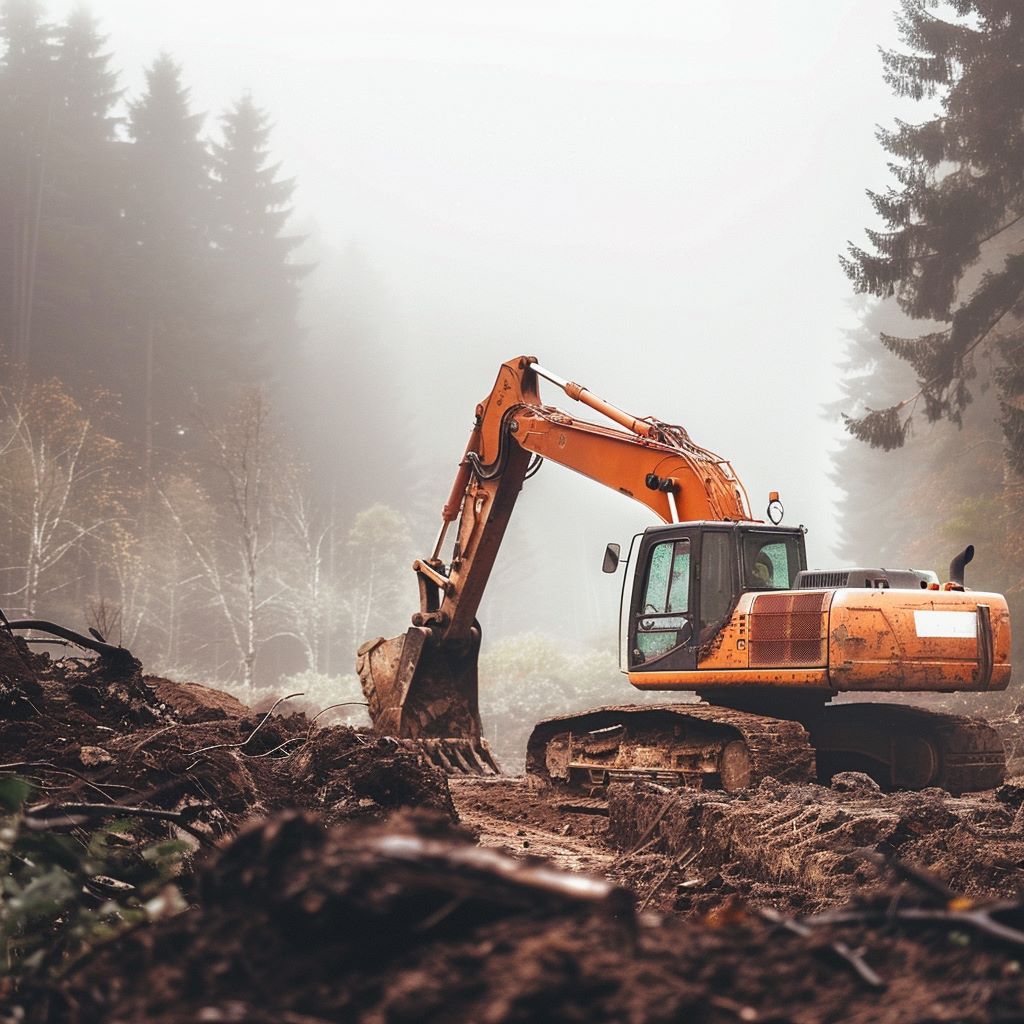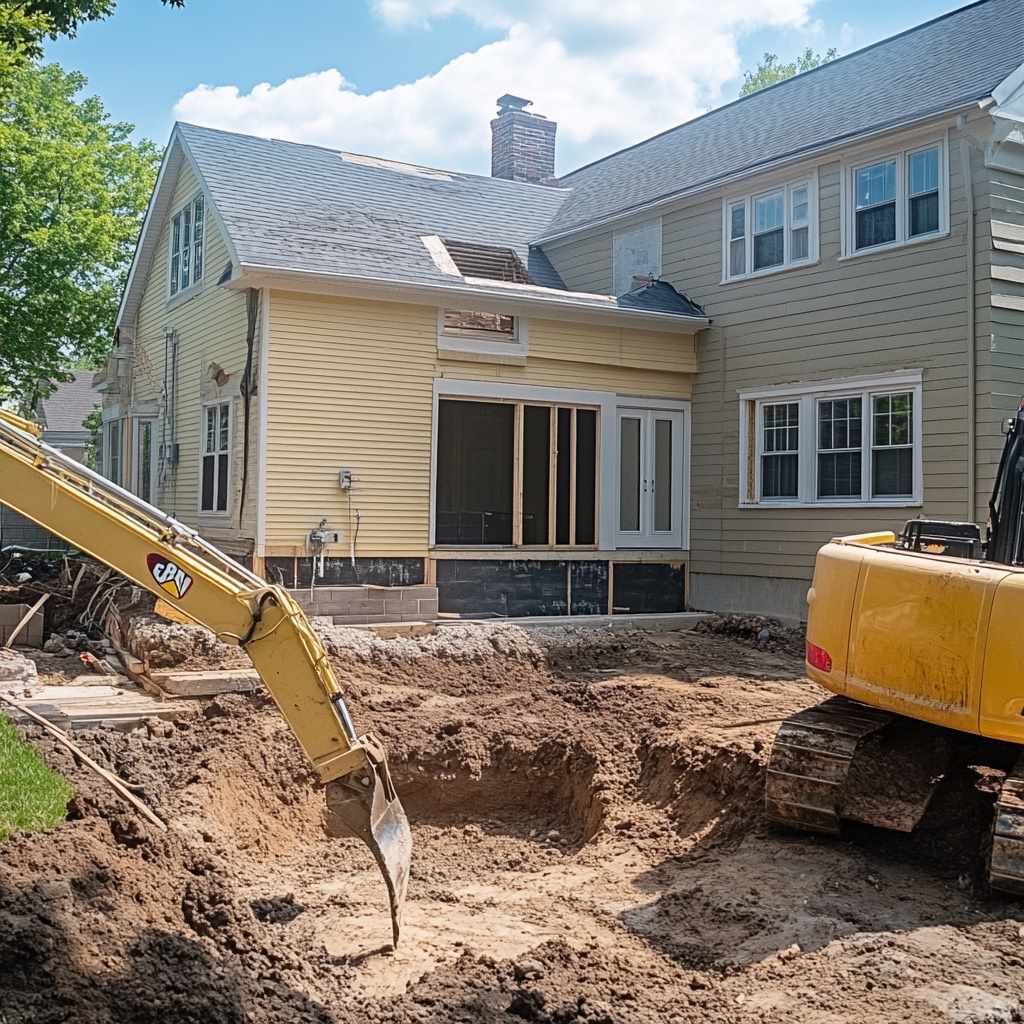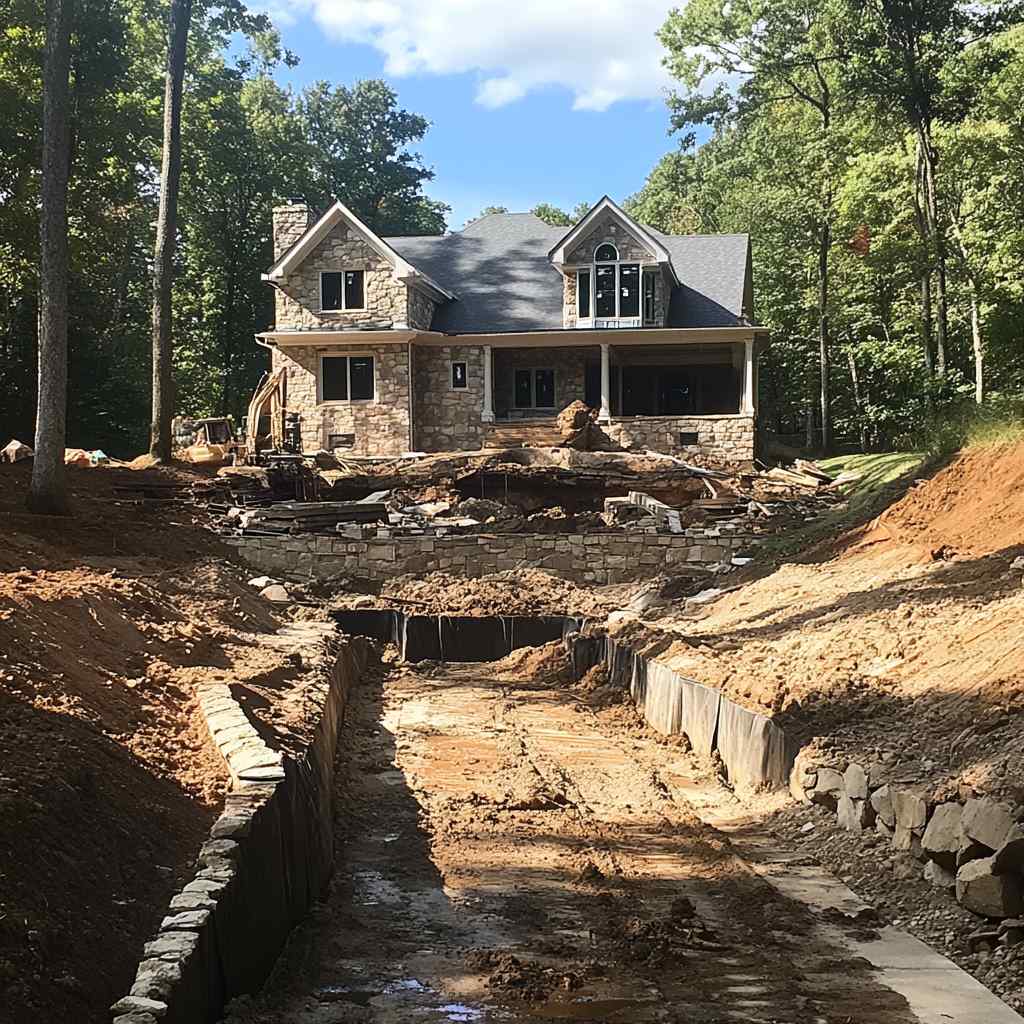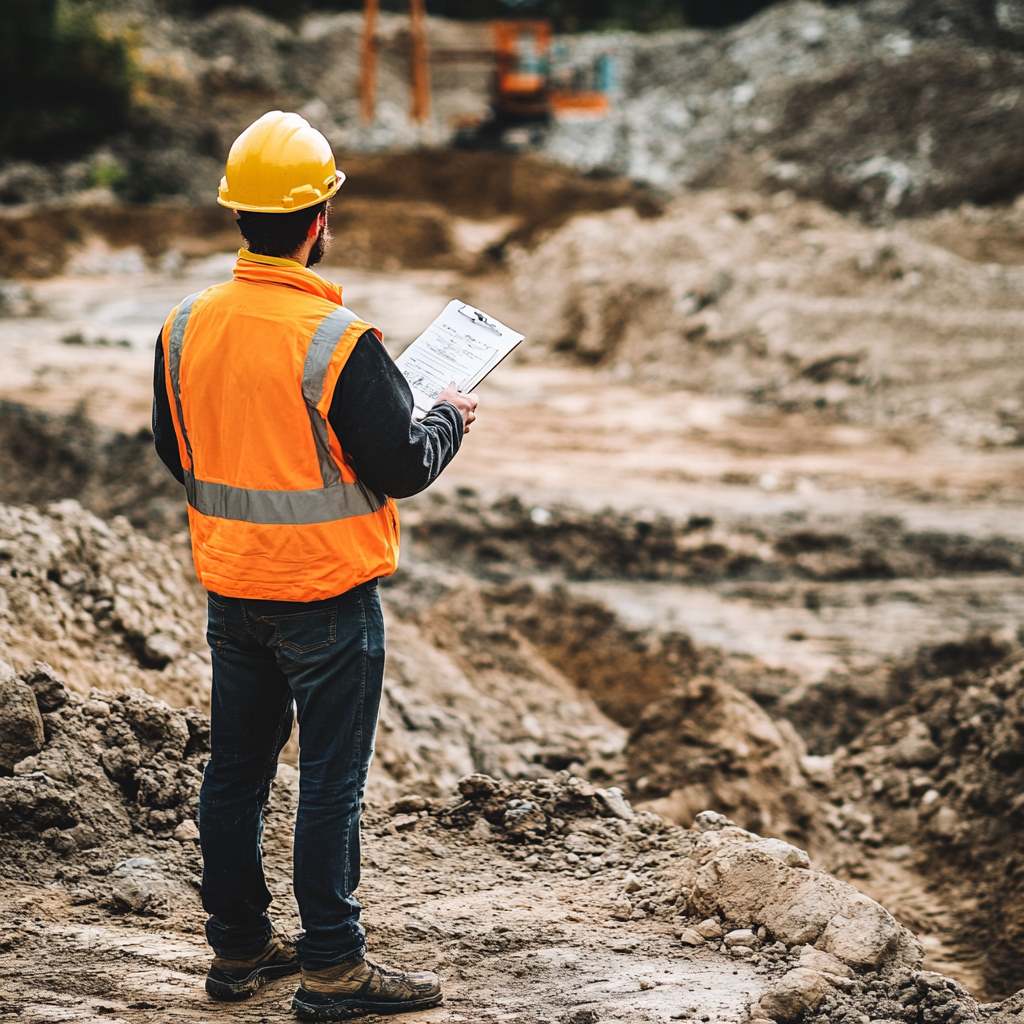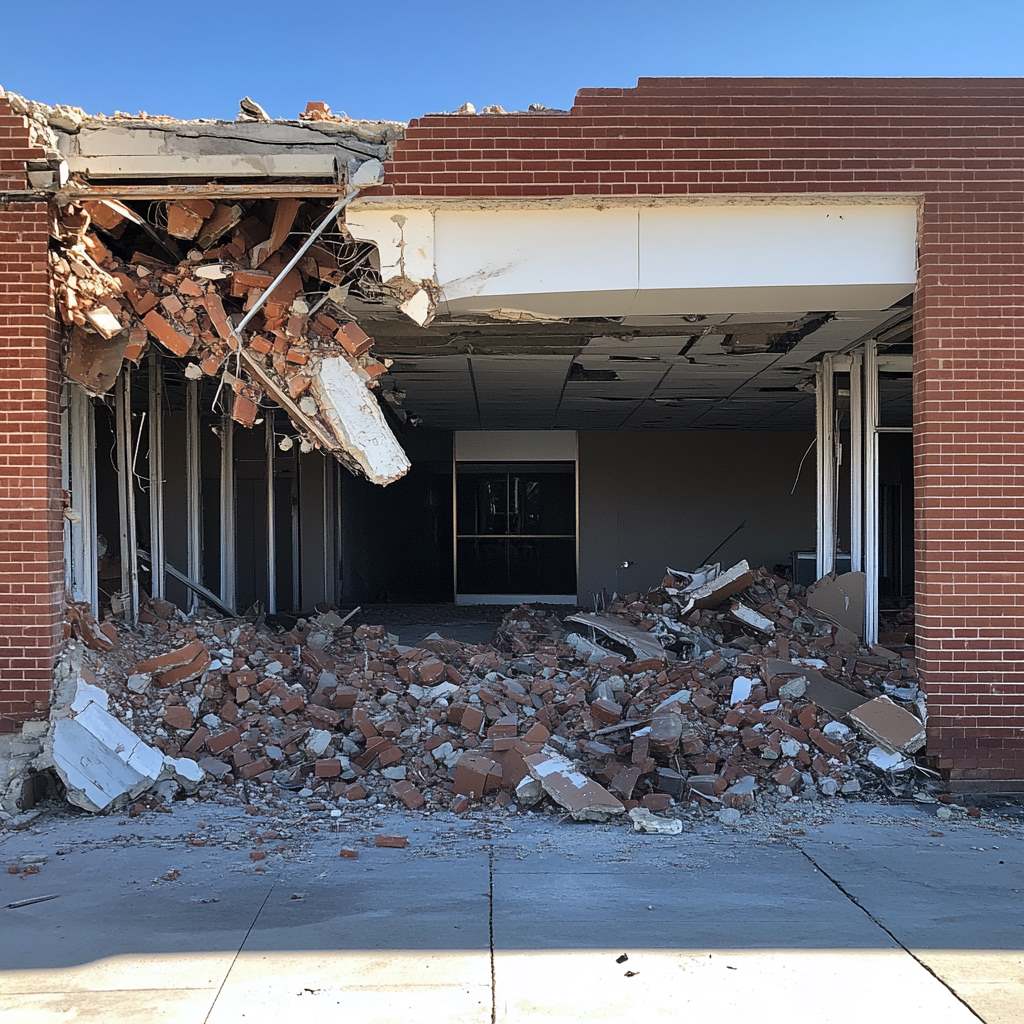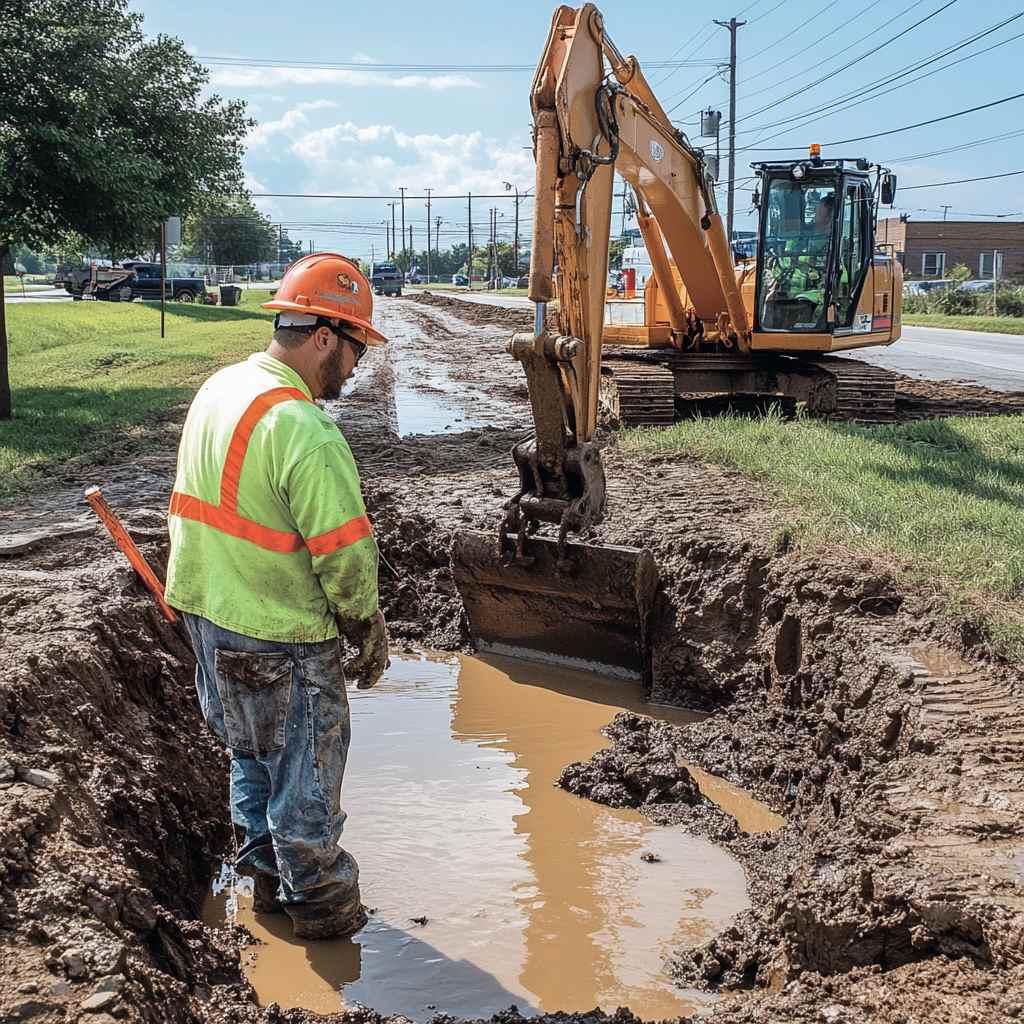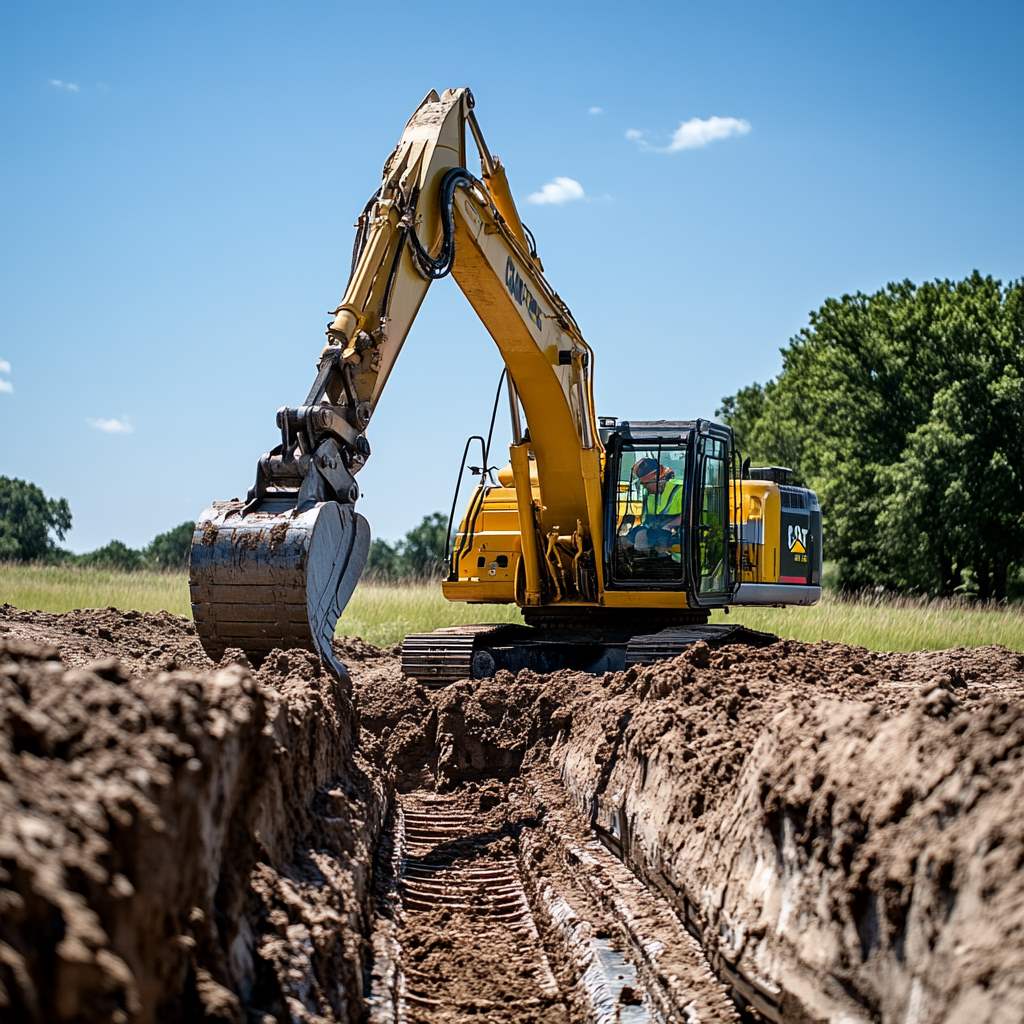Overview of Pond Excavation Costs in Snohomish County
The cost of excavating a pond in Snohomish County can vary greatly. Several factors influence the final price, such as pond size, soil conditions, and accessibility.
Basic Cost Breakdown
- Small Ponds usually cost between $3.08 and $8.97 per square foot.
- Large Ponds: You might pay between $1,200 to $6,800 per acre for larger projects.
- Excavation Only: Expect to spend $2,000 to $5,000+ per acre.
Additional Costs
Material Costs: Installing a pond liner or adding specific designs significantly impact overall expenses.
Labor Costs: Professional excavation services in the area are essential for accurate pricing. A foundation pad might range from $1,500 to $10,000.
Example Costs
- Foundation Pad: $1,500 to $10,000
- Digging a Basement: $1,500 to $10,000
- In-ground Pool: $1,000 to $5,000
Site-Specific Factors
Soil Type: Some soils are more accessible to dig than others, affecting both time and cost.
Accessibility: If your site is hard to reach, expect higher costs.
Permitting Requirements for Pond Excavation
When planning to excavate a pond in Snohomish County, you must first understand the permitting requirements. Proper permits ensure your project complies with local, state, and federal regulations.
You will need to obtain a permit if your pond:
- Is within 500 feet of a lake, river, or stream.
- Is situated in a regulated wetland.
- Falls within a 100-year floodplain.
- Has a surface area of 5 acres or greater.
Contact the Snohomish County Planning and Development Services (PDS) if you plan to excavate near these regulated areas. They can guide you through the necessary steps and required documents.
Common permits you may need include:
- Shoreline Management Permit: For ponds affecting streams, lakes, or wetlands.
- Grading Permit: For earthwork over 50 cubic yards.
- Flood Hazard Permit: If your pond is near a floodplain.
Each permit has different costs and application processes. The PDS website provides detailed instructions and application forms.
Additionally, the State Environmental Policy Act (SEPA) may require a detailed environmental review. This process evaluates potential environmental impacts and ensures that they are mitigated.
Check local ordinances as well. Snohomish County has specific codes and regulations governing land use and environmental protection.
You can call the PDS office or visit their website for accurate information. Always start your project with thorough research to avoid legal complications and fines.
Factors Affecting Excavation Costs
Excavating a pond involves several key factors that influence the overall cost. These include the pond’s size and depth, design and complexity, soil conditions and accessibility, and seasonal considerations.
Size and Depth of the Pond
The size and depth of the pond are critical factors in determining the excavation cost. Larger ponds or those with more depth require more excavation, leading to higher costs.
For example, moving more dirt can increase the hourly rates of excavators, which typically range from $100 to $300.
A small pond may cost less due to less excavation work, while a large pond may require substantial hours and energy, significantly increasing costs. Contractors calculate charges based on cubic yards of dirt moved or removed. Deep ponds will require more advanced equipment and safety measures, raising expenses.
Pond Design and Complexity
The design and complexity impact how much excavation will cost. A simple, round pond requires less detailed work than a complex, multi-tiered design.
Complex designs may have features like waterfalls, irregular shapes, or specific landscaping requirements.
Each design complexity increases the labor and time needed, thus raising costs. You might pay more for a pond with sophisticated elements due to meticulous digging and precise shaping. Straightforward designs are easier and faster to execute, reducing overall expenses.
Soil Conditions and Accessibility
Soil conditions and site accessibility significantly affect excavation costs. In areas with rocky, clay, or tough soil, excavating becomes challenging and time-consuming, increasing costs.
Loose or sandy soils, on the other hand, are easier and cheaper to work with.
Accessibility to the site is another crucial factor. Expect higher costs if your pond site is hard to reach, like a backyard with narrow access points.
Special equipment or additional labor might be needed to transport machinery and remove debris, contributing to the overall expense.
Seasonal Considerations
The time of year you plan to excavate can also influence costs. In regions with harsh winters like Snohomish County, excavating in colder months may be difficult and costly due to frozen ground and weather-related delays.
Spring or summer projects, when the ground is softer and weather conditions are more predictable, are typically more cost-effective. However, demand for excavation services can be higher in these seasons, potentially driving up prices due to increased competition for contractors’ availability.
Opting for off-peak seasons could provide some cost benefits despite the potential weather-related challenges.
Average Excavation Rates in Snohomish County
When planning to excavate a pond in Snohomish County, understanding the average costs is essential. Excavation rates in this area can vary based on several factors, such as the size and complexity of the project.
Typical excavation costs range from $1,500 to $10,000 for most small—to medium-sized projects. These can include foundation pads, digging a basement, or even preparing a site for a new home.
More complex jobs, like digging around an existing house or larger, deeper excavations, may cost between $5,000 and $15,000.
A per cubic yard rate might also be used. You can expect to pay between $2.50 and $15.00 per cubic yard.
Other factors influencing the rate include:
- Type of soil: Clay, sand, or rocky soil can impact labor and equipment needs.
- Depth of excavation: Deeper digs are more time-consuming and costly.
- Terrain and obstructions: Hilly or obstructed areas may require additional work and machinery.
Hourly rates for an excavator in Snohomish County generally fall around $100 to $300 per hour, depending on the job’s complexity and the machinery used.
Specific estimates may be required for particular projects. Foundation Pads, Basement Digging, and Swimming Pool Excavations have their own range, from $1,000 to $15,000, depending on their size and scope.
Cost Breakdown for Pond Excavation
Excavating a pond in Snohomish County involves several key cost factors. These include the initial preparation, labor and equipment, materials and transportation, and additional features. Each factor contributes to the overall expense, so it’s important to understand the details of each.
Preparation and Planning
Before excavation begins, you need to plan and prepare the site. This includes obtaining necessary permits, which can cost between $50 and $200 depending on local regulations.
Site assessment is crucial. Soil testing, site surveys, and drainage planning can add another $500 to $1,000. Professional consultation may also cost around $100 to $300.
Clearing vegetation and debris from the site generally costs $1 to $2 per square foot.
Material and Transportation
Transporting excavated material and needed supplies can be costly. Hauling excavated soil away might cost $2 to $5 per cubic yard.
If the soil is contaminated, disposal costs could be higher, potentially reaching up to $50 per cubic yard.
Material costs include liners, between $0.50 and $1.50 per square foot, and filters or pumps necessary for pond maintenance. These materials usually range from $200 to $1,000 depending on the pond size.
Additional Features
Adding features like landscaping, lighting, and water features introduces extra costs.
Landscaping costs can vary widely, from $500 for simple grass and plants to $5,000 for elaborate designs with waterfalls.
Installing lighting around the pond might range from $15 to $100 per light. Pumps and filtration systems are essential for maintaining water quality and can cost between $300 and $1,500, depending on the complexity and size of the pond system.
Hiring a Professional Excavator
When hiring a professional excavator for your pond in Snohomish County, you need to focus on assessing contractor qualifications, understanding contract terms, and the excavation project timeline.
Assessing Contractor Qualifications
When hiring an excavator, check their experience and credentials. Ensure they have a valid license and insurance. It’s important that the contractor has experience in excavating ponds, specifically.
Ask for references and follow up with previous clients to understand their experience. Review their portfolio and see if they have successfully completed similar projects. This will give you confidence in their ability to handle your specific needs.
Another key point is to confirm the contractor uses modern and well-maintained equipment. Outdated machinery can lead to project delays and increased costs. Lastly, make sure they comply with local regulations and environmental guidelines.
Understanding Contract Terms
Before signing any contract, read it thoroughly. Ensure all costs are clearly outlined, including labor, equipment, and materials. Be aware of any potential additional fees. Make sure the contract specifies a start and end date.
Payment terms should be clear. Understand the payment schedule and check if there are any penalties for late payment or incentives for early completion. This helps you manage your budget effectively.
It’s also crucial to include a clause that addresses unexpected issues. Whether it’s hidden rocks, weather delays, or equipment failure, having a clear plan in the contract for handling these issues can save you time and money. Make sure both parties agree on these terms to avoid disputes.
Excavation Project Timeline
Discuss the timeline with the contractor before beginning the project. Understand the phases of the excavation process. Typically, it starts with site inspection, planning, excavation, and clean-up.
Ensure the contractor provides a detailed schedule. Knowing when each phase will be completed helps coordinate other aspects of the project, such as landscaping or pond filling.
Be prepared for possible delays, such as bad weather or unexpected challenges. It’s advisable to have some buffer time in your schedule. Communicate regularly with the contractor for updates on progress to stay informed and ensure the project remains on track.
Cost-Saving Tips for Pond Excavation
- Plan Ahead: Proper planning can save you time and money. Determine the size, shape, and depth of your pond before starting, to avoid costly changes later.
- DIY When Possible: If you have the skills and equipment, doing some work yourself can reduce labor costs. Consider tasks like clearing the site or basic digging.
- Rent Equipment: Renting excavation equipment instead of buying it can save you thousands. Look for local rental services in Snohomish County.
- Get Multiple Quotes: Obtain quotes from several contractors. Compare their rates and services to ensure you get the best deal.
- Use Local Resources: Utilize local materials like soil and rocks. Transporting materials from distant places can increase costs due to fuel and labor.
- Check Permits: Check local regulations and obtain necessary permits. Fines for not having permits can add unnecessary expenses.
- Seasonal Timing: Excavating during off-peak seasons can lower costs. Contractors are often less busy and may offer discounts.
- Consider Smaller Ponds: If budget concerns, opt for a smaller pond. You can always expand it later when more funds are available.
- Effective Drainage: Plan for proper drainage to avoid future repairs. Poor drainage can lead to erosion or other issues that are costly to fix.
Environmental Considerations and Impact
When planning to excavate a pond in Snohomish County, you must consider both environmental impact and the necessity of following local regulations to ensure the project is eco-friendly and legally compliant.
Assessing Environmental Impact
Excavating land can significantly affect the environment. The removal of dirt can disrupt habitats for wildlife and plant species. Clearing the area can lead to soil erosion if the exposed soil isn’t properly managed, leading to water pollution in nearby streams and rivers.
Dust and debris created during excavation can affect air quality. It’s important to plan measures to control dust, such as using water sprays or barriers. Understanding these impacts helps you make informed decisions to minimize environmental adverse effects.
Regulatory Compliance
Before beginning excavation, make sure to understand Snohomish County’s regulations. Various permits may be required, including environmental assessments and approval from local agencies. Non-compliance can result in fines and delays, so make sure all legal requirements are met.
Check if special considerations are needed, such as protection of wetlands or endangered species habitats. Keeping up with local laws ensures a smoother project and helps protect the environment effectively.
Maintenance and Upkeep Costs Post-Excavation
Maintaining your pond after excavation involves several ongoing costs. Regular upkeep ensures the pond remains functional, attractive, and healthy. Here are some common maintenance activities and their associated costs:
Water Quality Management
Regular pond water testing for pH, nitrate, and ammonia levels is essential. Test kits typically cost between $20 and $50. Chemicals to adjust water quality might also be needed, costing about $30 to $100 annually.
Pond Liner Repair
Pond liners can develop leaks over time. Patching kits usually cost between $10 and $30, but for more significant repairs, hiring a professional could cost around $200 to $500.
Algae Control
Algae can be a recurring issue. Algaecides and natural remedies like barley straw pellets can each run about $20 to $50 per treatment, which may be needed multiple times a year.
Debris Removal
Falling leaves and other debris require regular removal. Basic pond nets cost about $10 to $30, while a pond vacuum can range from $50 to $300.
Pump and Filter Maintenance
Pond pumps and filters need regular cleaning and occasional replacement. Filters typically cost between $20 and $50, and pumps, depending on their size, can range from $100 to $300.
Fish and Plant Care
If you stock your pond with fish or aquatic plants, factor in food and healthcare for these. Annual costs for fish food alone can vary from $50 to $150, not including potential vet care or new plant purchases.
Frequently Asked Questions
The average pond excavation cost ranges from $3,000 to $15,000 per acre. This price range varies based on the project’s complexity and specific site conditions.
Yes, soil type significantly impacts costs. Rocky or clay-heavy soils are harder to dig and may require specialized equipment, increasing expenses. Sandy soils generally cost less to excavate.
Additional expenses include permits, which cost between $150 and $485, landscaping, liner installation, and potential drainage systems. Equipment rental or contractor fees are also common costs to consider.
Permitting requirements can add to the total project cost. Excavating more than 5,000 square feet typically requires permits ranging from $150 to $485. Compliance with local regulations can also involve extra inspection fees.
Smaller ponds cost more per square foot because of fixed equipment and labor costs. Larger ponds benefit from economies of scale, reducing the per-acre cost significantly as the size increases.
